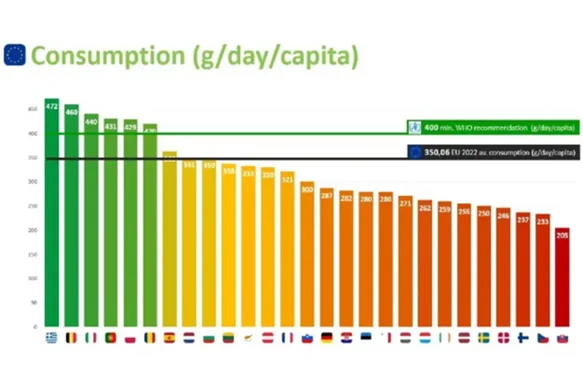Europeans Still Falling Short of 400g/Day Fresh Produce Recommendation
Freshfel Europe’s latest Consumption Monitor reveals a significant decline in fresh produce consumption across Europe, highlighting a worrying trend. The report, which compares consumption trends in the EU-27 based on Eurostat and FAOstat data, shows that the average fruit and vegetable intake fell to 350g per day per capita in 2022. This represents a 5% decrease from 2021 and is almost 3% below the average of the past five years. Alarmingly, this figure is over 12% below the World Health Organization’s (WHO) recommended minimum of 400g per day per capita.

Market Contraction
The monitor indicates that only six EU countries met the recommended daily intake of 400g of fresh fruits and vegetables in 2022, highlighting significant room for improvement. The overall EU-27 fresh produce market shrank to 71.35 million tonnes, reversing the positive trend seen during the Covid-19 pandemic, when healthier lifestyles and environmental consciousness were on the rise. However, the economic crisis, rising prices, and inflation in 2022 pressured consumers to reduce their fresh produce intake, favoring cheaper and more energy-dense foods.
Freshfel Europe’s latest Consumption Monitor reveals that the average fruit and vegetable consumption in the EU dropped to 350 g/day per capita in 2022. The positive trend that began during the COVID-19 pandemic has been disrupted by the economic crisis, affecting consumers’ purchasing power.
In times of economic uncertainty, consumers often opt for less healthy diets perceived as more filling and affordable than fruits and vegetables. Preliminary data for 2023/24 confirms this declining trend, with many areas seeing more than a 10% drop, erasing the post-pandemic growth in consumption.
Factors Influencing Trends
Freshfel Europe’s discussions with its members identified several factors driving these trends, including reduced household purchases, a greater impact on lower-income households, pressure on organic and premium products, increased purchase frequency with smaller quantities, and higher prices compensating for lower sales volumes.
In 2022, the EU-27 fresh produce market size contracted to 71,350,965 tonnes. This decline ended the positive trend initiated in 2020 during the pandemic, which had prompted Europeans to adopt healthier lifestyles and increased their awareness of environmental and climate issues. However, by 2022, fruit and vegetable consumption faced renewed pressure across the EU due to the economic crisis, rising prices, and widespread inflation, which reduced consumers’ purchasing power, leading them to opt for more affordable alternatives.
As the EU’s current legislative term nears its end, doubts arise regarding the success of promoting a more plant-based diet. Despite initiatives like the European Green Deal, Farm to Fork Strategy, and Circular Economy Action Plan, policies lack coherence and consistency. Efforts to prioritize fresh produce fell short, missing the opportunity to elevate the role of fruits and vegetables in diets. Advocates stress the importance of recognizing fruits and vegetables as essential for addressing societal challenges.
Recommendations suggest raising consumption targets to 800 g/capita/day and addressing obstacles hindering growth. Emphasizing benefits, dispelling misconceptions, and enhancing accessibility are key. Collaboration between the fruit and vegetable sector and authorities is crucial to promote sustainable consumption and address the urgency of the consumption challenge, particularly among younger generations.
Read the Press Release below
Freshfel Europe’s Consumption Monitor shows that there is still a long way to go to reach the minimum recommendation of 400 g/day of fresh fruit and vegetables

